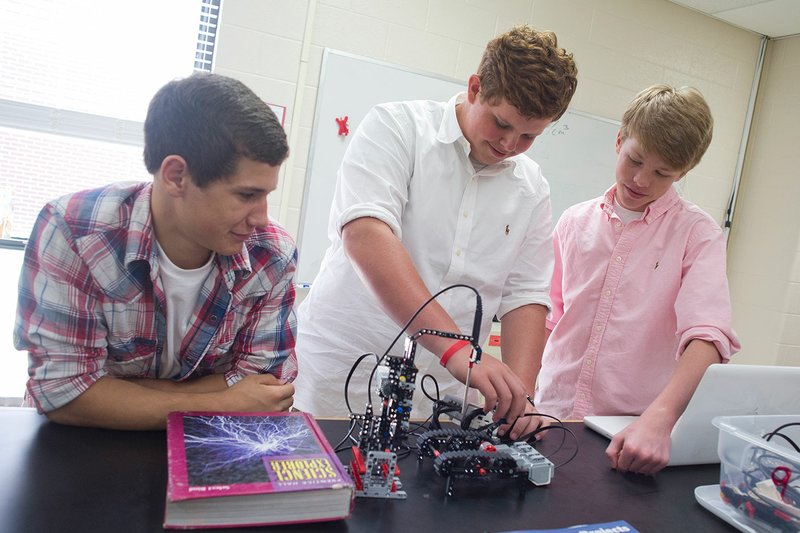BEEBE — With the push of a button, gears turn as a machine comes to life in a classroom at Beebe Junior High School. Three eighth-graders in Tate Rector’s engineering class have created a robot that both utilized their engineering knowledge and met a need — the need to eat a snack without burning their tongues.
Noah Jolly, Caleb Barrentine and Taylor Boyce have developed a Hot Pocket robot, which tests the internal temperature of a Hot Pocket so the consumer knows if the item is either too hot or too cold. In addition to keeping their mouths safe from scalding Hot Pocket filling, the students’ project earned them first place in the 2015 Vernier Engineering Contest.
Vernier Software and Technology developed the contest to see if educators and students could come up with creative solutions for everyday problems using Vernier sensors. Noah, Caleb and Taylor’s robot uses both Vernier sensors and Lego Mindstorms Education EV3 robotic technology to operate.
The robot itself has a short conveyor system on which a user places the Hot Pocket. Then the machine moves the pastry forward, and a temperature probe is inserted into the snack. If the Hot Pocket is not at an ideal temperature, the device lets the user know.
“Have you ever eaten a Hot Pocket before? Have you ever burnt your tongue?” Noah asked. “This robot tells you if it’s too hot or too cold to eat. We researched the temperature where it would burn your tongue. If it’s more than that temperature, it will let you know. If it’s in the range
between where it’s too hot or too cold, it says it’s good.”
The students found that a Hot Pocket is too hot to consume at 150 degrees. The robot detects an acceptable Hot Pocket if it measures an internal temperature between 110 and 150 degrees.
Like with many engineering projects, the students had to make several adjustments to make the robot work. After the first prototype, they added a second motor to the conveyor belt to better move the snack, made the conveyor belt taller, lifted the motors off the ground and added tape to the probe holder so the probe would not fall off.
All three of the students said the project opened their eyes to the world of engineering, and they might consider pursuing careers in science and engineering.
“It seems like something pretty cool to do,” Noah said. “Everything you do is fun. If you could have a job where you’re making stuff, it seems pretty cool to me.”
In order to enter the 2015 Vernier Engineering Contest, the students had to make a. video of their project in action. Noah, Caleb and Taylor said making the video was a lot of fun, and they were glad to see their hard work pay off. To view the video, visit www.youtube.com/watch?t=142&v=6Opd-UHuIlc
Staff writer Angela Spencer can be reached at (501) 244-4307 or aspencer@arkansasonline.com.
